Pickleball is a popular sport played in many places. Unfortunately, due to the nature of the game, it can produce quite a bit of noise. In this article, we will be exploring different solutions for pickleball noise issues.
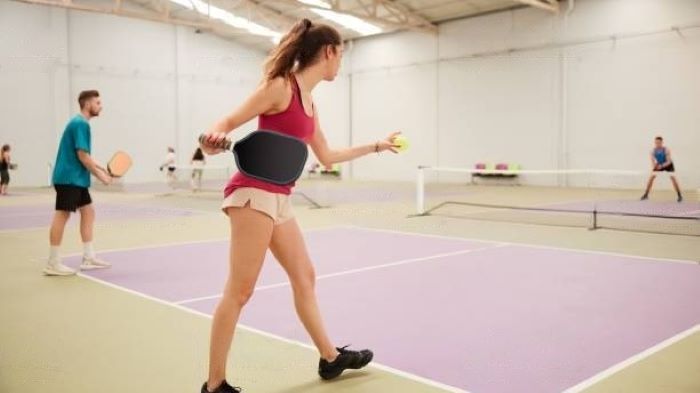
We will discuss how softer paddles and balls can help reduce noise levels and use sound-absorbing materials and designated areas for playing. We’ll also use sound barriers and court maintenance to decrease noise levels.
Finally, we’ll look at alternative surfaces that can help absorb any excess sound created by the game. So, let’s get started!
Where Does Pickleball Noise Come From?
Pickleball noise comes from the paddle, the ball, and the court.
The paddle strikes the ball and creates a loud popping sound. The plastic whiffle ball has holes and whistles as it flies through the air. The court is the surface that the ball bounces on and can amplify noise depending on the material and condition.
Some factors that affect pickleball noise levels are:
- The Type and Quality of the Paddle: Some paddles are made of wood, metal, or composite materials that produce different sounds. Generally, soft paddles are quieter than harder ones.
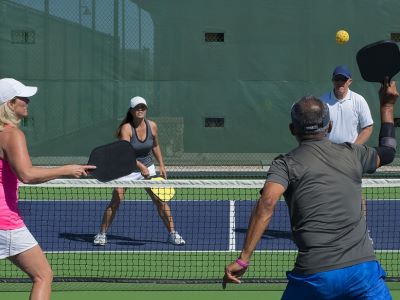
- The Type and Quality of the Ball: Some balls are softer, lighter, or have fewer holes than others. These factors can influence how much noise the ball makes when hit or bounced.
- The Distance and Direction of the Noise: The farther away the noise source is, the less loud it will be. The direction of the noise can also affect how it travels and reaches others’ ears.
- Weather and Wind Conditions: Weather and wind can affect how sound travels and is loud. For example, humid air can make the sound louder, while windy conditions can make the sound quieter or louder depending on the direction.
- The Time of Day and Background Noise: The time of day can affect how noticeable pickleball noise is compared to other sounds in the environment. For example, pickleball noise may be more noticeable at night when it is quieter than during the day when there are more sounds. Background noise can mask or enhance pickleball noise depending on frequency and intensity.
Solution for Pickleball Noise
The sport of pickleball is growing in popularity. Unfortunately, the noise associated with pickleball games can be disruptive to nearby residents and businesses. To reduce pickleball noise, several solutions can be implemented.
1. Use Softer Paddles and Balls
One of the most effective ways to reduce pickleball noise is to use softer paddles and balls. These products are designed to produce less sound when they hit each other or the court. They also have less impact on the court surface and can prevent damage and wear.
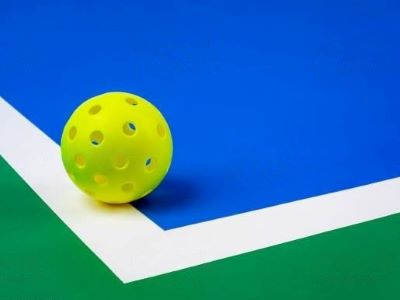
You can find softer paddles and balls online or at your local sports store. They may cost more than regular ones, but they are worth it if you want to play pickleball quietly and respectfully.
2. Using Sound Absorbing Materials
Using sound-absorbing materials around the court is another solution to pickleball noise. In addition to dampening the noise, these materials may also prevent it from spreading to other areas. Here are some examples of sound-absorbing materials:
- Acoustic Panels: Designed to absorb sound waves, the panels can be installed on fences, walls, and roofs to reduce noise. You can choose from a variety of sizes, shapes, colors, and materials to meet your preferences and needs.
- Acoustic Blankets: These thick blankets can be hung over fences, walls, or roofs to block and absorb sound. They are usually made of heavy-duty fabric that can withstand outdoor conditions and provide insulation and privacy.
- Acoustic Curtains: These are similar to acoustic blankets but are lighter and more flexible. They can cover windows, doors, or openings to reduce noise and light. They are also easy to install and remove as needed.
3. Designated Area
A third solution to pickleball noise is to designate a specific pickleball area away from residential or sensitive areas. It can help avoid disturbing your neighbors or violating noise regulations.
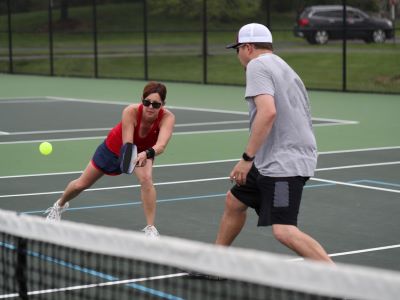
You can also inform your neighbors about your pickleball schedule and ask for their cooperation and understanding. You can also invite them to join you and play pickleball with you. It can help build a positive relationship and community.
4. Use Sound Barriers
Using sound barriers around the court is a fourth solution to pickleball noise. The purpose of sound barriers is to reflect or deflect sound waves so they don’t reach other areas. The following are examples of sound barriers:
- Wall: A wall is a solid structure that blocks sound from passing through it. There are many materials that can be used to make these structures, including concrete, brick, stone, wood, metal, and more. It is also possible to decorate or paint them in order to make them more attractive and appealing.
- Fences: Contrary to walls, fences have gaps or openings that allow air and light to pass through. Materials such as wood, metal, wire, vinyl, and others can be used to make them. You can also cover them with plants or vines to make them look more natural.
- Hedge: A hedge is a row of plants or shrubs that act as a natural sound barrier. In addition to providing shade, privacy, and aesthetic value, they can also provide a sense of comfort. It is possible to trim or shape them according to your preferences and needs.
5. Court Maintenance
A fifth solution for pickleball noise is maintaining the court properly and regularly. A well-maintained court can reduce the noise level and improve the playing experience. Some tips for maintaining the court are:
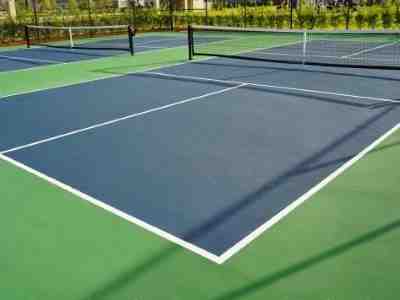
- Clean the court surface regularly to remove dirt, dust, debris, or stains that can affect the bounce and sound of the ball.
- Repair any cracks, holes, or damages on the court surface that can cause unevenness or loudness.
- Apply a sealant or coating on the court surface to protect it from weathering and wear and tear.
- Replace any worn-out or damaged paddles or balls that can produce more noise or harm the court surface.
6. Using Alternative Surfaces
A sixth solution to pickleball noise is to use alternative court surfaces that are quieter and softer than concrete or asphalt. Some examples of alternative surfaces are:
- Clay: This natural material is made of fine-grained soil particles compacted together. It has a smooth and soft texture that reduces the ball’s impact and noise. It also has a reddish-brown color that blends well with the environment.
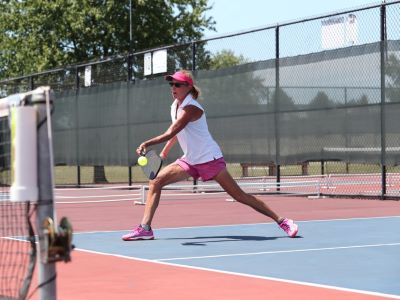
- Grass: Plants that grow on the ground produce grass, another natural material. It has a green and lush appearance that creates a pleasant and relaxing atmosphere. It also has a cushioning effect that absorbs the sound and shock of the ball.
- Rubber: It is a synthetic material made of elastic polymers molded into sheets or tiles. It has a rubbery, resilient feel that bounces the ball quietly. It also has a variety of colors and patterns that suit your style and taste.
These solutions to pickleball noise will make your game more enjoyable and respectful of yourself and others. Following these suggestions, you can play pickleball without annoying your neighbors or violating noise ordinances.
FAQs
The USAPA is focusing on developing new materials and technologies that reduce pickleball paddle noise. It includes testing different rubber, foam, and other materials to find an optimal combination for reducing noise. They also look at improving the paddle head design to decrease sound when striking the ball.
Use quieter balls such as foam or rubber to reduce pickleball noise, ensure the court surface is well maintained and not overly loud when hit, and maintain proper court etiquette (quieter voices). Additionally, investing in noise-reducing materials such as soundproofing foam or acoustic barriers can help reduce the amount of noise produced.
Pickleball makes so much noise because it is a fast-paced game with players hitting the ball back and forth over the net. It creates a loud sound as the ball bounces off the paddle and court.
The best way to soundproof an outdoor pickleball court is to install acoustic panels along the court’s walls and a sound-absorbing material (such as foam or fiberglass insulation) on the floor and ceiling. Adding barriers such as fences or shrubs can also help reduce noise levels.
Let’s, Wrap Up!
In conclusion, pickleball noise can be a nuisance to the community, but specific steps can be taken to reduce its impact.
Using softer paddles and balls, incorporating sound-absorbing materials into the court area, designating a particular place for playing pickleball, using sound barriers as needed, and regularly maintaining the court surface are all potential solutions for reducing pickleball noise.
With these measures in place, everyone in the community can enjoy peace while enjoying their favorite pastime.

I am a professional physiotherapist and the author of the BallSportsPro. I worked with athletes of all levels, from amateur to professional, and i helped them overcome injuries and improve their performance. I am a certified Pickleball instructor and has been playing the sport for over 10 years.
